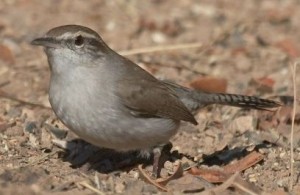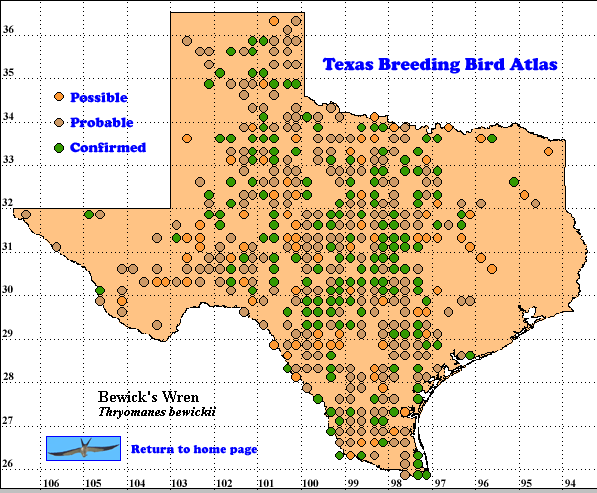Bewick’s Wren is an enigmatic taxon in need of much more study including genetic analyses. As many as 19 subspecies have been recognized on the basis of range, size and color. Vocal differences have been noted between several locations. The range of this wren has varied historically. Since 1821 when this wren was collected and described by Audubon, birds moved into the eastern United States as habitat was created by clearance of forests for farms and pastures. This range expansion populated most of the eastern United States west of New England and extended from the Great Lakes to the Gulf Coast. While this wave crested in some areas as late as the 1930s, it had started to recede in others in the 1920s; the range contraction continued until at least the 1970s. This reversal is thought to be due to reforestation of abandoned farms and competition for nest sites with the more aggressive House Wren (Troglodytes aedon). Today only small populations of Bewick’s Wrens remain east of the Mississippi River (Kennedy and White 1997, Pyle 1997, Kroodsma 2005, Sauer et al. 2005).
DISTRIBUTION. During the 1987-1992 field work seasons of the TBBA project, atlasers found most breding evidence in the Rolling Plains, Edwards Plateau, South Texas Brush Country and Coastal Sand Plain regions (see the region map in Lockwood and Freeman [2004]). North American Breeding Bird Survey observers found relative abundances of 30-100 Bewick’s Wrens per 40 km (25 mi) route in adjoining areas of the Edwards Plateau and South Texas Brush Country. The BBS and TBBA maps are similar in appearance. Relative abundances fall as low as 3-10 in South Texas and the Panhandle (Sauer et al. 2005).).
BBS data also indicate higher relative abundances of Bewick’s Wren along the Pacific Coast from southern British Colombia to southern California and in Arizona, New Mexico and Oklahoma and in smaller areas within Nevada, Utah, Colorado and Missouri (Sauer et al. 2005). In Mexico this wren is resident throughout Baja California and the higher elevations of the mainland south to the Isthmus of Tehuantepec (Howell and Webb 1995).
SEASONAL OCCURRENCE. Bewick’s Wren is a resident year-round in Texas where it breeds from early February to mid-August, based on egg dates from February 26 to July 22 (Oberholser 1974, Lockwood and Freeman 2004). TBBA observations agree with dates ranging from March 11 (a bird on a nest) to August 5. Data from 155 clutches in Texas show 9% initiated in March, 44% in April, 38% in May, 8% in June and 1% in July (Kennedy and White 1997). In the Trans-Pecos mountains, the breeding season may be closer to the April to July period reported for Arizona (Corman 2005).
BREEDING HABITAT. Bewick’s Wrens breed in Texas from near sea level to 2600 m (8500 ft) in thickets and brush in semi-arid situations, often hilly. (Oberholser 1974). The Oklahoma Breeding Bird Atlas describes the habitat preferences of this wren as including dense thickets (around yards or on farms) and rocky hillsides and canyons (Howery 2004). In Mexico this species breeds in arid and semi-arid scrub, open areas with scattered trees and bushes, brushy thickets and gardens (Howell and Webb 1995).
At higher elevations in the Trans-Pecos, breeding habitats may be similar to those in Arizona where 34% of breeding observations were in pinyon-juniper and 28% in riparian habitats (Corman 2005). In Colorado about 2/3 of graphed observations came from pinyon-juniper woodlands and almost 1/5 came from riparian habitats (Levad. 1998).
Nests are often placed in cavities and are frequently found around human dwellings in sites ranging from natural tree cavities, old woodpecker holes and nest boxes to mailboxes, crevices in walls and trash piles. The nest is a bulky mass of twigs, wood chips, dead leaves and human debris. On this foundation a cup is built of feathers, hair, moss and leaves. Nest sites and nests are similar to those of House Wrens (Harrison 1979, Kennedy and White 1997).
In this cup, the female usually lays 5-7 (range 3-8) smooth, white eggs (see Harrison [1979] for a photo of markings). The eggs hatch after 14-16 days of incubation by the female and the young leave the nest 14-16 days later. They are fed by their parents for another 2 weeks. Most pairs raise only 1 brood, a few early nesters raise 2 (Kennedy and White 1997).
STATUS. Bewick’s Wrens are uncommon to common residents of the western 2/3 of Texas and formerly bred east along the coast to Jefferson and San Jacinto counties (Lockwood and Freeman 2004). The BBS map of relative abundances suggests that Texas probably has the largest population of Bewick’s Wrens of any of the United States. Texas has 124 BBS routes on which this species was detected out of a total of 582 in the United States and Canada. BBS trend data suggest that essentially no change has occurred in populations of this wren in Texas and the United States and Canada in the period 1980-2005 (Sauer et al. 2005).
Text by Robert C. Tweit (2006)
Literature cited.
Corman, T. E. 2005. Bewick’s Wren (Thryomanes bewickii). In Arizona breeding bird atlas. pp. 408-409 (T. E. Corman and C. Wise-Gervais, eds.). University of New Mexico Press, Albuquerque.
Harrison, H. H. 1979. A field guide to western birds’ nests. Houghton Mifflin, Boston, MA.
Howell, S. N. G. and S. Webb. 1995. A guide to the birds of Mexico and northern Central America. Oxford University Press, New York.
Howery, M. 2004. Bewick’s Wren (Thryomanes bewickii) In Oklahoma breeding bird atlas, pp. 318-319 (D. L. Reinking, ed.). University of Oklahoma Press, Norman.
Kennedy, E. D and D. W. White. 1997. Bewick’s Wren (Thryomanes bewickii). In The birds of North America, No. 315 (A. Poole and F. Gill, eds.). The Birds of North America, Inc., Philadelphia, PA.
Kroodsma, D. 2005. The singing life of birds. Houghton Mifflin, Boston MA.
Levad, R. 1998. Bewick’s Wren (Thryomanes bewickii). In Colorado breeding bird atlas, pp. 368-369 (H. E. Kingery, ed.), Colorado Bird Atlas Partnership, Denver.
Lockwood, M. W. and B. Freeman. 2004. The TOS handbook of Texas birds. Texas A&M University Press, College Station.
Oberholser, H. C. 1974. The bird life of Texas. University of Texas Press, Austin.
Pyle, P. 1997. Identification guide to North American birds, part 1. Slate Creek Press, Bolinas, CA.
Sauer, J. R., J. E. Hines, and J. Fallon. 2005. The North American Breeding Bird Survey, results and analysis 1966-2005. Version 6.2 2006. USGS Patuxent Wildlife Research Center, Laurel MD < http://www.mbr-pwrc.usgs.gov/bbs>

